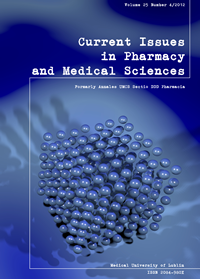Gamma-glutamyl transferase (GGT) activity and lipid concentration in patient with coronary artery disease (CAD)
DOI:
https://doi.org/10.12923/j.2084-980X/25.4/a.03Keywords:
gamma-glutamyl transferase, GGT, high-sensitivity C reactive protein, (hsCRP), stable coronary artery disease , CADAbstract
A serum lipid profiles are established risk factors for atherosclerosis. High sensitivity C-reactive protein (hsCRP) level, are a powerful predictor of future myocardial infarction and cardiac death among apparently healthy individuals. The aim of this study was to investigate serum GGT activity and hsCRP level and others atherosclerosis biochemistry markers in patients with stable coronary artery disease. We studied 94 (women, n=45 and men, n=49), mean age was 64.8±9.7 years, consecutive patients with stable coronary artery disease (CAD), hospitalized in the Department of Cardiology Cardinal Wyszyński Hospital in Lublin. Patients with acute coronary syndroms (ACS) in history where 53% (n=51) of studied population (unstable angina n=3; no ST elevation myocardial infarction n=17, ST elevation myocardial infarction n=31). The patients with acute and chronic kidney disease, liver diseases, active autoimmune disease, malignancy, thyroids diseases, alcohol disease were excluded from the analysis. The patients had worse laboratory parameters than the reference group. They had increased concentration of TG, hsCRP and GGT activity, and decreased concentration of HDL-C as compared to the reference group. However, ALT activity and creatinine concentration were non-significantly increased vs. the controls. We concluded that dyslipidemia together with GGT activity and hsCRP concentration may be good markers to predict cardio-vascular events and vessels lesions in asymptomatic patients with CAD. However, these results require further studies.
References
1. Aksakal E. et al.: The relation of serum gamma-glutamyl transferase levels with coronary lesion complexity and long-term outcome in patients with stable coronary artery disease. Atherosclerosis., 221, 2, 2012.
2. Azar RR. et al.: Relation of C-reactive protein to extent and severity of coronary narrowing in patients with stable angina pectoris or abnormal exercise tests. Am J Cardiol., 86, 2000.
3. Bogavac-Stanojević N. et al.: Lipid and inflammatory markers for the prediction of coronary artery disease: A multi-marker approach. Clinical Biochemistry., 40, 2007.;
4. Breitling L.P. et al.: Gamma-glutamyltransferase and prognosis in patients with stable coronary heart disease followed over 8 years. Atherosclerosis., 210, 2010.
5. Demir S. et al.: The Importance of Gamma-Glutamyltransferase Activity in Patients with Coronary Artery Disease Clin. Cardiol., 32, 4, 2009.
6. Erren M. et al.: Systemic inflammatory parameters in patients with atherosclerosis of the coronary and peripheral arteries. Arterioscler Thromb Vasc Biol., 19, 1999.
7. Fox K. et al.: Guidelines on the management of stable angina pectoris. Eur Heart J., 7, 8, 2006.
8. Franzini M. et al.: Glutamyltransferase activity in human atherosclerotic plaques—Biochemical similarities with the circulating enzym. Atherosclerosis, 202, 2009.
9. Haverkate F. et al. for the European Concerted Action on Thrombosis and Disabilities Angina Pectoris Study Group.: Production of C-reactive protein and risk of coronary events in stable and unstable angina. Lancet, 349, 1997.
10. Liu J. et al.: Evaluation of serum levels of C-reactive protein and lipid profiles in patients with chronic periodontitis and/or coronary heart disease in an ethnic Han population. Quintessence international, 41, 3, 2010.
11. Mendall MA. et al.: C-reactive protein and its relation to cardiovascular risk factors: A population based cross sectional study. BMJ., 312, 1996
12. Morrow DA., Ridker PM.: C-reactive protein, inflammation, and coronary risk. Med Clin North Am., 84, 2001.
13. Pai J.K. et al.: Inflammatory markers and the risk of coronary heart disease in men and women. N. Engl. J. Med., 351, 2004.
14. Paolicchi A. et al.: Human atherosclerotic plaques contain gamma-glutamyl transpeptidase enzyme activity. Circulation, 109, 2004.
15. Saijo Y. et al.: The relationship of gamma-glutamyltransferase to C-reactive protein and arterial stiffness. Nutrition, Metabolism & Cardiovascular Diseases, 18, 2008.
16. Stanojević N.B. et al.: Cost-effectiveness analysis in diagnosis of coronary artery disease: Choice of laboratory markers. Clinical Biochemistry, 40, 2007.
17. Taniguchi H. et al.: Associations of plasma C-reactive protein levels with the presence and extent of coronary stenosis in patients with stable coronary artery disease. Atherosclerosis, 178, 2005.
18. Zebrack J.S. et al.: C-reactive protein and angjographic coronary artery disease: independent and additive predictors of risk in subjects with angina. J Am Coll Cardiol., 39, 2002.
Downloads
Published
Issue
Section
License
Copyright (c) 2012 Authors

This work is licensed under a Creative Commons Attribution-NonCommercial-NoDerivatives 3.0 Unported License.


